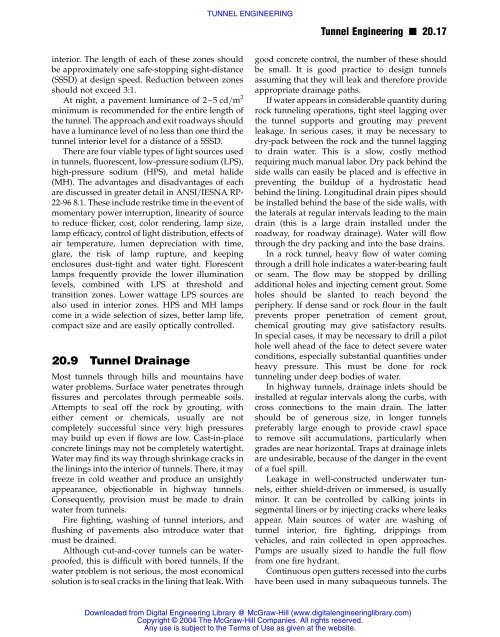TUNNEL ENGINEERING
TUNNEL ENGINEERING
TUNNEL ENGINEERING
You also want an ePaper? Increase the reach of your titles
YUMPU automatically turns print PDFs into web optimized ePapers that Google loves.
interior. The length of each of these zones should<br />
be approximately one safe-stopping sight-distance<br />
(SSSD) at design speed. Reduction between zones<br />
should not exceed 3:1.<br />
At night, a pavement luminance of 2–5 cd/m 2<br />
minimum is recommended for the entire length of<br />
the tunnel. The approach and exit roadways should<br />
have a luminance level of no less than one third the<br />
tunnel interior level for a distance of a SSSD.<br />
There are four viable types of light sources used<br />
in tunnels, fluorescent, low-pressure sodium (LPS),<br />
high-pressure sodium (HPS), and metal halide<br />
(MH). The advantages and disadvantages of each<br />
are discussed in greater detail in ANSI/IESNA RP-<br />
22-96 8.1. These include restrike time in the event of<br />
momentary power interruption, linearity of source<br />
to reduce flicker, cost, color rendering, lamp size,<br />
lamp efficacy, control of light distribution, effects of<br />
air temperature, lumen depreciation with time,<br />
glare, the risk of lamp rupture, and keeping<br />
enclosures dust-tight and water tight. Florescent<br />
lamps frequently provide the lower illumination<br />
levels, combined with LPS at threshold and<br />
transition zones. Lower wattage LPS sources are<br />
also used in interior zones. HPS and MH lamps<br />
come in a wide selection of sizes, better lamp life,<br />
compact size and are easily optically controlled.<br />
20.9 Tunnel Drainage<br />
Most tunnels through hills and mountains have<br />
water problems. Surface water penetrates through<br />
fissures and percolates through permeable soils.<br />
Attempts to seal off the rock by grouting, with<br />
either cement or chemicals, usually are not<br />
completely successful since very high pressures<br />
may build up even if flows are low. Cast-in-place<br />
concrete linings may not be completely watertight.<br />
Water may find its way through shrinkage cracks in<br />
the linings into the interior of tunnels. There, it may<br />
freeze in cold weather and produce an unsightly<br />
appearance, objectionable in highway tunnels.<br />
Consequently, provision must be made to drain<br />
water from tunnels.<br />
Fire fighting, washing of tunnel interiors, and<br />
flushing of pavements also introduce water that<br />
must be drained.<br />
Although cut-and-cover tunnels can be waterproofed,<br />
this is difficult with bored tunnels. If the<br />
water problem is not serious, the most economical<br />
solution is to seal cracks in the lining that leak. With<br />
<strong>TUNNEL</strong> <strong>ENGINEERING</strong><br />
Tunnel Engineering n 20.17<br />
good concrete control, the number of these should<br />
be small. It is good practice to design tunnels<br />
assuming that they will leak and therefore provide<br />
appropriate drainage paths.<br />
If water appears in considerable quantity during<br />
rock tunneling operations, tight steel lagging over<br />
the tunnel supports and grouting may prevent<br />
leakage. In serious cases, it may be necessary to<br />
dry-pack between the rock and the tunnel lagging<br />
to drain water. This is a slow, costly method<br />
requiring much manual labor. Dry pack behind the<br />
side walls can easily be placed and is effective in<br />
preventing the buildup of a hydrostatic head<br />
behind the lining. Longitudinal drain pipes should<br />
be installed behind the base of the side walls, with<br />
the laterals at regular intervals leading to the main<br />
drain (this is a large drain installed under the<br />
roadway, for roadway drainage). Water will flow<br />
through the dry packing and into the base drains.<br />
In a rock tunnel, heavy flow of water coming<br />
through a drill hole indicates a water-bearing fault<br />
or seam. The flow may be stopped by drilling<br />
additional holes and injecting cement grout. Some<br />
holes should be slanted to reach beyond the<br />
periphery. If dense sand or rock flour in the fault<br />
prevents proper penetration of cement grout,<br />
chemical grouting may give satisfactory results.<br />
In special cases, it may be necessary to drill a pilot<br />
hole well ahead of the face to detect severe water<br />
conditions, especially substantial quantities under<br />
heavy pressure. This must be done for rock<br />
tunneling under deep bodies of water.<br />
In highway tunnels, drainage inlets should be<br />
installed at regular intervals along the curbs, with<br />
cross connections to the main drain. The latter<br />
should be of generous size, in longer tunnels<br />
preferably large enough to provide crawl space<br />
to remove silt accumulations, particularly when<br />
grades are near horizontal. Traps at drainage inlets<br />
are undesirable, because of the danger in the event<br />
of a fuel spill.<br />
Leakage in well-constructed underwater tunnels,<br />
either shield-driven or immersed, is usually<br />
minor. It can be controlled by calking joints in<br />
segmental liners or by injecting cracks where leaks<br />
appear. Main sources of water are washing of<br />
tunnel interior, fire fighting, drippings from<br />
vehicles, and rain collected in open approaches.<br />
Pumps are usually sized to handle the full flow<br />
from one fire hydrant.<br />
Continuous open gutters recessed into the curbs<br />
have been used in many subaqueous tunnels. The<br />
Downloaded from Digital Engineering Library @ McGraw-Hill (www.digitalengineeringlibrary.com)<br />
Copyright © 2004 The McGraw-Hill Companies. All rights reserved.<br />
Any use is subject to the Terms of Use as given at the website.
















